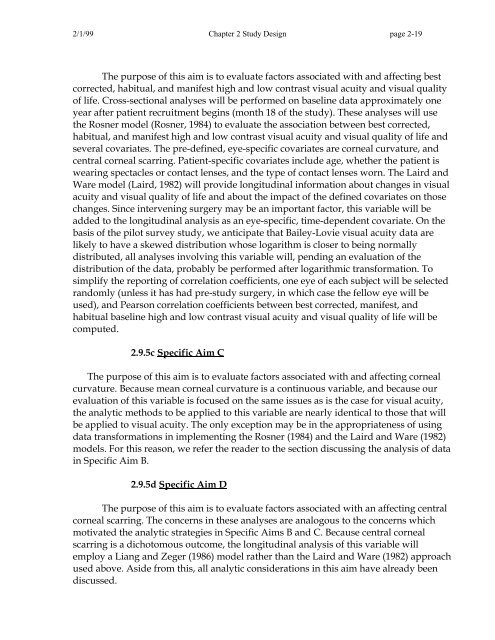OM t of c.iii - Vision Research Coordinating Center - Washington ...
OM t of c.iii - Vision Research Coordinating Center - Washington ...
OM t of c.iii - Vision Research Coordinating Center - Washington ...
You also want an ePaper? Increase the reach of your titles
YUMPU automatically turns print PDFs into web optimized ePapers that Google loves.
2/1/99 Chapter 2 Study Design page 2-19<br />
The purpose <strong>of</strong> this aim is to evaluate factors associated with and affecting best<br />
corrected, habitual, and manifest high and low contrast visual acuity and visual quality<br />
<strong>of</strong> life. Cross-sectional analyses will be performed on baseline data approximately one<br />
year after patient recruitment begins (month 18 <strong>of</strong> the study). These analyses will use<br />
the Rosner model (Rosner, 1984) to evaluate the association between best corrected,<br />
habitual, and manifest high and low contrast visual acuity and visual quality <strong>of</strong> life and<br />
several covariates. The pre-defined, eye-specific covariates are corneal curvature, and<br />
central corneal scarring. Patient-specific covariates include age, whether the patient is<br />
wearing spectacles or contact lenses, and the type <strong>of</strong> contact lenses worn. The Laird and<br />
Ware model (Laird, 1982) will provide longitudinal information about changes in visual<br />
acuity and visual quality <strong>of</strong> life and about the impact <strong>of</strong> the defined covariates on those<br />
changes. Since intervening surgery may be an important factor, this variable will be<br />
added to the longitudinal analysis as an eye-specific, time-dependent covariate. On the<br />
basis <strong>of</strong> the pilot survey study, we anticipate that Bailey-Lovie visual acuity data are<br />
likely to have a skewed distribution whose logarithm is closer to being normally<br />
distributed, all analyses involving this variable will, pending an evaluation <strong>of</strong> the<br />
distribution <strong>of</strong> the data, probably be performed after logarithmic transformation. To<br />
simplify the reporting <strong>of</strong> correlation coefficients, one eye <strong>of</strong> each subject will be selected<br />
randomly (unless it has had pre-study surgery, in which case the fellow eye will be<br />
used), and Pearson correlation coefficients between best corrected, manifest, and<br />
habitual baseline high and low contrast visual acuity and visual quality <strong>of</strong> life will be<br />
computed.<br />
2.9.5c Specific Aim C<br />
The purpose <strong>of</strong> this aim is to evaluate factors associated with and affecting corneal<br />
curvature. Because mean corneal curvature is a continuous variable, and because our<br />
evaluation <strong>of</strong> this variable is focused on the same issues as is the case for visual acuity,<br />
the analytic methods to be applied to this variable are nearly identical to those that will<br />
be applied to visual acuity. The only exception may be in the appropriateness <strong>of</strong> using<br />
data transformations in implementing the Rosner (1984) and the Laird and Ware (1982)<br />
models. For this reason, we refer the reader to the section discussing the analysis <strong>of</strong> data<br />
in Specific Aim B.<br />
2.9.5d Specific Aim D<br />
The purpose <strong>of</strong> this aim is to evaluate factors associated with an affecting central<br />
corneal scarring. The concerns in these analyses are analogous to the concerns which<br />
motivated the analytic strategies in Specific Aims B and C. Because central corneal<br />
scarring is a dichotomous outcome, the longitudinal analysis <strong>of</strong> this variable will<br />
employ a Liang and Zeger (1986) model rather than the Laird and Ware (1982) approach<br />
used above. Aside from this, all analytic considerations in this aim have already been<br />
discussed.
















